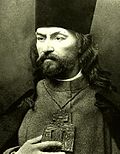Bloody Sunday (1905)
Bloody Sunday took place in Russia in 1905. More than 3,000 people marched towards the Winter Palace in hopes of presenting Tsar Nicholas II a petition for reform, however he was not present at the palace. [1] Without the order of the tsar to stop them, the army shot their rifles into the crowd, leaving 96 dead and around 300 wounded.[2]
This event began the Russian Revolution of 1905 which was caused in part by defeat in the Russo-Japanese War. Many thousands died and the Tsar created the State Duma to represent the Russian people. It is considered a cause of the later, larger Russian Revolution.[3]
Later Dmitri Shostakovich composed his 11th Symphony based on this event. Bloody Sunday is also known as a massacre. The Winter Palace is where the Tsar spent his winter holidays.
Bloody Sunday (1905) Media
Georgy Gapon, a Russian Orthodox priest, led the workers' procession to present a petition to the tsar on January 22 [O.S. January 9] 1905, known as Bloody Sunday Still from the Soviet movie Devyatoe Yanvarya ("9th of January") (1925) showing a line of armed soldiers facing demonstrators at the approaches to the Winter Palace in St Petersburg
References
- ↑ "Bloody Sunday 1905". Russian Revolution. 2012-12-03. Retrieved 2021-03-15.
- ↑ "Bloody Sunday". The British Library. Archived from the original on 2021-10-21. Retrieved 2021-03-15.
{{cite web}}: More than one of|archivedate=and|archive-date=specified (help); More than one of|archiveurl=and|archive-url=specified (help) - ↑ "Russian Revolution of 1917". cs.mcgill.ca. Archived from the original on 2021-02-25. Retrieved 2021-03-15.
{{cite web}}: More than one of|archivedate=and|archive-date=specified (help); More than one of|archiveurl=and|archive-url=specified (help)


